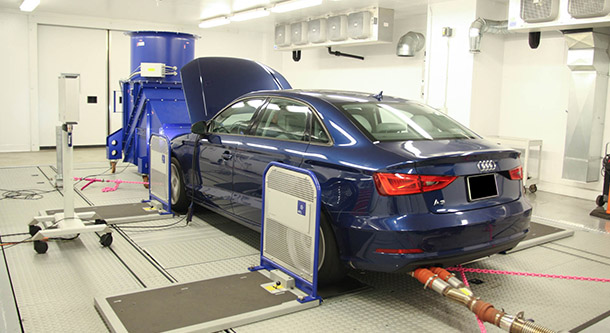
ORLANDO, Fla. (Dec. 12, 2017) – According to new research from AAA, premium gasoline offers some benefit to select vehicles, but is becoming increasingly expensive for drivers. In recent years, the price gap between premium and regular-grade gasoline has risen from a historically steady 10 percent to 25 percent or more per gallon. While past AAA research has shown no benefit in using premium gasoline in a vehicle designed to operate on regular fuel, new testing indicates that some vehicles – those that recommend, but do not require premium gasoline – may see increased fuel economy and performance under certain driving conditions when using the higher-octane gasoline. Unfortunately, the high cost of premium gasoline may outweigh that advantage for many drivers. As a result, AAA recommends drivers weigh the potential benefits against the cost of using premium gasoline, if their vehicle does not require it.
“AAA’s testing reveals that drivers could see modest gains in fuel economy and performance when opting for premium gasoline in vehicles that recommend, but do not require, the higher-octane fuel,” said Megan McKernan, manager of the Automobile Club of Southern California’s Automotive Research Center. “Those seeking the maximum capabilities of their performance-focused or utility vehicle may see some benefit from using premium gasoline, particularly over the long haul.”
In partnership with the Automobile Club of Southern California’s Automotive Research Center, AAA tested a variety of vehicles that recommend, but do not require, the use of premium (91 octane or higher) gasoline. Although drivers of these vehicles are unlikely to see any benefit from using premium gasoline during typical city or highway driving, a combination of laboratory and on-road tests were performed to simulate extreme driving scenarios such as towing, hauling cargo and aggressive acceleration. When using premium fuel in these vehicles under these conditions, AAA tests found that:
- Fuel economy for test vehicles averaged a 2.7 percent improvement. Individual vehicle test result averages ranged from a decrease of 1 percent (2016 Audi A3) to an improvement of 7.1 percent (2016 Cadillac Escalade).
- Horsepower for test vehicles averaged an increase of 1.4 percent. Individual vehicle test result averages ranged from a decrease of 0.3 percent (2016 Jeep Renegade) to an improvement of 3.2 percent (2017 Ford Mustang).
- According to national averages, the price difference between regular and premium gasoline is approximately 20 to 25 percent, or 50 cents per gallon.
- The modest fuel economy improvements found in AAA tests do not offset the higher cost of premium gasoline.
“There’s no question that higher-octane premium fuel has the potential to boost a vehicle’s fuel economy and performance, however, engines have to be calibrated to require that fuel to see the full benefit,” said Greg Brannon, AAA’s director of Automotive Engineering. “Based on AAA’s testing, vehicles that only recommend premium gasoline can’t take full advantage of higher octane fuel and, as a result, the benefit that comes from upgrading to premium gasoline may not offset its high cost.”
Last year, nearly 1.5 million new vehicles sold in the United States recommend, but do not require, premium gasoline. The trend toward recommending or requiring higher-octane fuel continues to rise as manufacturers work toward meeting stringent CAFE (Corporate Average Fuel Economy) standards. However, a vehicle that requires the more expensive premium gasoline may dissuade a car buyer, leaving automakers to balance higher performance with what consumers desire. Rising prices for premium gasoline, coupled with great variation in prices across the country, compounds this issue. AAA urges drivers who use premium gasoline to shop around for the best price, as it could vary dramatically between gas stations in any given city. The AAA Mobile app, available for iPhone, iPad and Android, can help drivers identify the least expensive premium gasoline near them.
“The gap between premium and regular gas has been steadily rising since 2009, with the most dramatic increase occurring in the last two years,” said Jeanette Casselano, AAA gas price expert. “Fewer than five years ago, only a 10 percent gap existed between premium and regular. Today, that spread has doubled with premium gasoline costing almost 50 cents more per gallon and is still climbing despite the fact that consumer demand for premium isn’t necessarily increasing. ”
For those vehicles that do not recommend or require premium gasoline, AAA suggests drivers opt for the lower priced, regular fuel. In a study released last year, AAA found that consumers wasted nearly $2.1 billion dollars fueling these vehicles with higher-octane gasoline. However, drivers of vehicles that require premium gasoline should always use it. Additionally, any vehicle that makes a “pinging” or “knocking” sound while using regular gasoline should be evaluated by a repair facility and likely switched to a higher-octane fuel. Drivers seeking a higher quality fuel for their vehicle should consider using one that meets Top Tier standards, as previous AAA research found it to keep engines up to 19 times cleaner.
The full report, fact sheet and other information regarding this study can be found on the AAA NewsRoom.
As North America’s largest motoring and leisure travel organization, AAA provides more than 58 million members with travel, insurance, financial and automotive-related services. Since its founding in 1902, the not-for-profit, fully tax-paying AAA has been a leader and advocate for the safety and security of all travelers. Motorists can map a route, identify gas prices, find discounts, book a hotel and access AAA roadside assistance with the AAA Mobile app for iPhone, iPad and Android. Learn more at AAA.com/mobile. AAA clubs can be visited on the Internet at AAA.com.
